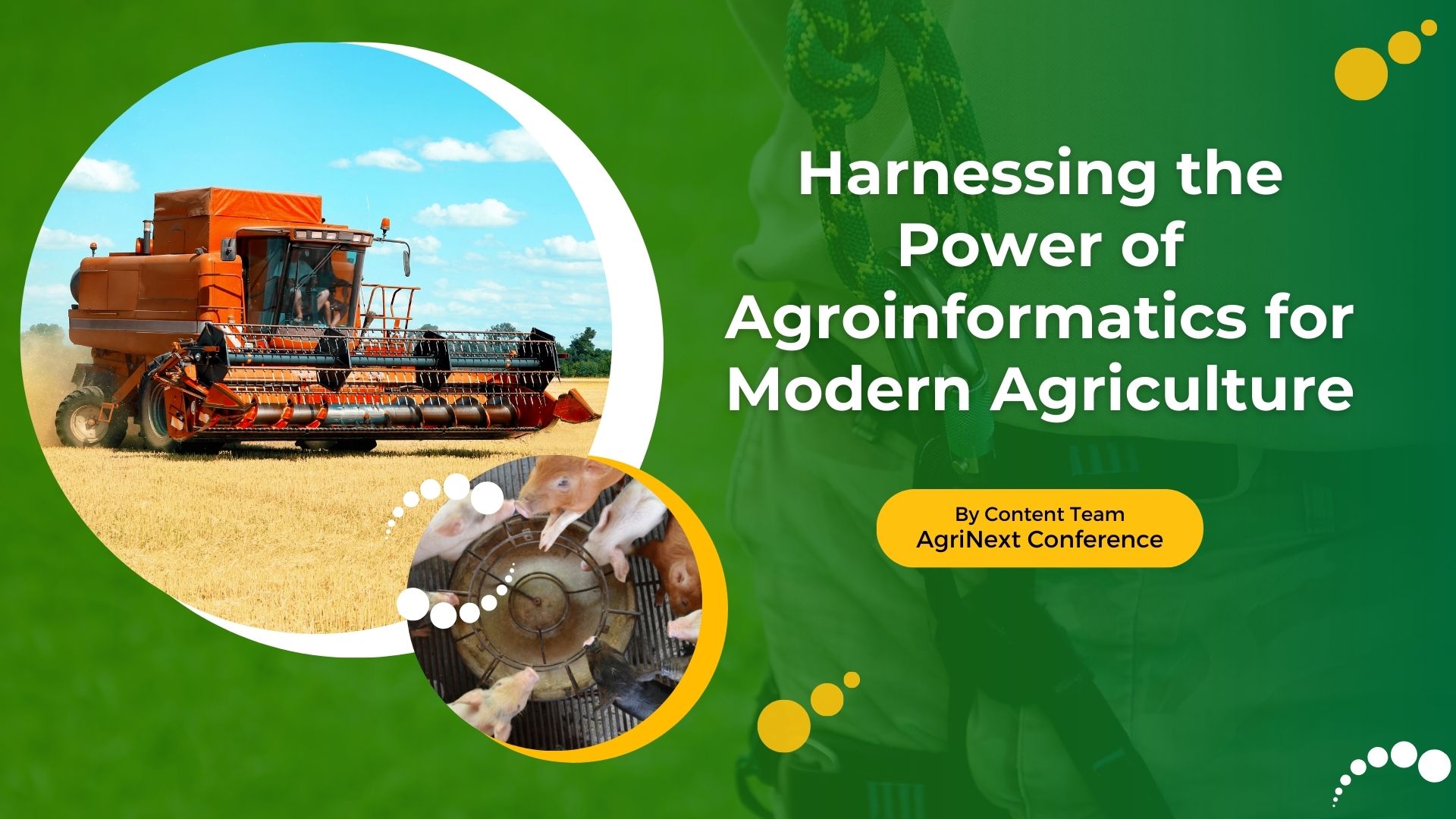
“Agroinformatics is not just about managing agricultural data; it’s about transforming that data into actionable insights that drive sustainable agricultural practices.”
David Tilman ,a noted ecologist
Introduction
In the 21st century, agriculture is undergoing a profound transformation, and at the heart of this revolution lies the fusion of agriculture and information technology- aptly named agroinformatics.In an era where data drives innovation, agriculture is no exception.Agroinformatics is emerging as a crucial field that blends traditional farming practices with cutting-edge information technology, making the way for more efficient, sustainable, and productive agriculture.
What is Agroinformatics?
Agroinformatics refers to the application of data analysis, computer science, and information technology in agriculture. This wide ranging field aims to enhance decision-making, resource management, and productivity through the intelligent use of data and technology.
The Importance of Agroinformatics
In this age, agro-informatics is essential for various reasons, a few of which include food security, agriculture sustainability, bio energy, natural resource conservation, carbon accounting, global climate change, policy formation, decision making and others.
Agroinformatics offers innovative solutions to these challenges by utilizing data to optimize farming practices, reduce waste, and improve crop yields.
Across the last decades various development and research efforts have been initiated to fully utilize the potential of Information and Communication Technology (ICT) for improvement,and sustainable development of agriculture.
Key Components of Agroinformatics
Data Collection and Management
Sensors and IoT Devices:
Modern farms are equipped with a variety of sensors that collect data on soil moisture, temperature, humidity, and crop health. Internet of Things (IoT) devices transmit this data in real-time, providing farmers with critical insights.
Drones and Satellite Imagery:
Drones and satellites are used to monitor large agricultural fields. They capture high-resolution images and data, helping farmers to detect issues like pest infestations or nutrient deficiencies early.
Data Analysis and Decision Support
Big Data Analytics:
The vast amount of data collected from various sources is analyzed using big data techniques. This analysis helps in understanding patterns, predicting outcomes, and making informed decisions.
Machine Learning and AI:
Artificial intelligence (AI) and machine learning algorithms can predict crop yields, detect diseases, and optimize resource use. These technologies learn from historical data to provide accurate recommendations.
Geographic Information Systems (GIS)
Precision Agriculture:
GIS technology enables site-specific crop management by mapping and analyzing spatial data. Farmers can apply the right amount of inputs (water, fertilizer, pesticides) precisely where needed, reducing waste and improving efficiency.
Land Use and Planning:
GIS aids in effective land use planning and management, ensuring that agricultural practices are sustainable and environmentally friendly.
Climate Modeling and Forecasting
Weather Prediction:
Accurate weather forecasts are vital for planning agricultural activities. Agroinformatics uses advanced models to predict weather conditions, helping farmers to plan planting, irrigation, and harvesting schedules.
Climate Change Impact:
By analyzing climate data, agroinformatics helps in understanding the long-term impacts of climate change on agriculture. This knowledge is crucial for developing strategies to mitigate adverse effects.
Applications of Agroinformatics
Crop Management: Precision farming techniques enhance crop management by optimizing planting, pest and disease control, and nutrient application.
Supply Chain Optimization: Agroinformatics streamlines supply chains by improving logistics, reducing post-harvest losses, and enhancing market access.
Sustainable Practices: By enabling efficient resource use and minimizing environmental impact, agroinformatics supports sustainable agricultural practices.
Challenges and Future Directions
Data Quality and Accessibility:
Ensuring the accuracy and accessibility of data is a major challenge. There is a need for standardized protocols and infrastructure to manage agricultural data effectively.
Technological Adoption:
While large-scale farms are quick to adopt new technologies, small-scale farmers often face barriers due to cost and lack of technical knowledge. Efforts are needed to make these technologies affordable and user-friendly.
Future Trends:
The future of agroinformatics looks promising with advancements in blockchain technology for traceability, advanced robotics for automated farming, and enhanced predictive models for better decision-making.
The Food and Agriculture Organization (FAO) leads several agro-informatics initiatives and platforms aimed at improving agricultural practices and food security globally. One prominent example is the Agricultural Market Information System (AMIS):
Agricultural Market Information System (AMIS):
Purpose: AMIS was established to enhance food market transparency and encourage coordination of policy responses to food price volatility. It aims to improve data reliability, timeliness, and comparability.
Functions: AMIS collects, analyzes, and circulates information on global food markets, particularly for key commodities like wheat, maize, rice, and soybeans. It provides early warning of potential food crises and helps policymakers make informed decisions.
Collaboration: The platform involves several international organizations, including the FAO, World Food Programme (WFP), International Food Policy Research Institute (IFPRI), and others.
Other notable FAO-led agro-informatics initiatives include:
FAO Hand-in-Hand Geospatial Platform:
Purpose: This platform aims to support the FAO’s Hand-in-Hand Initiative by providing geospatial data and analytics to identify opportunities and address gaps in agricultural and rural development.
Functions: It integrates various data sources, including satellite imagery, socioeconomic data, and agricultural statistics, to create comprehensive maps and visualizations. This helps stakeholders make data-driven decisions for sustainable development.
Global Information and Early Warning System (GIEWS):
Purpose: GIEWS provides timely and accurate information on food supply and demand, crop prospects, and food security conditions.
Functions: It monitors global food supply and demand, crop production, and market prices. The system issues regular reports and alerts to inform policymakers and humanitarian organizations about potential food security risks.
These FAO-led platforms utilizes agro-informatics to enhance global food security, support sustainable agricultural development, and improve the resilience of food systems.
Conclusion
Agroinformatics holds the potential to transform agriculture by making it more efficient, sustainable, and resilient. By utilizing the power of data and technology, farmers can optimize their practices, reduce waste, and increase productivity, ensuring food security for future generations.
Agroinformatics platforms play an important role in transforming agricultural practices through data-driven insights and advanced technologies. Notably, FAO-led initiatives like the Agricultural Market Information System (AMIS), the Hand-in-Hand Geospatial Platform, and the Global Information and Early Warning System (GIEWS) exemplify the power of leveraging data to enhance food security, improve market transparency, and support sustainable agricultural development. These platforms underscore the importance of international collaboration and innovation in addressing the complex challenges facing global agriculture today.
The integration of agroinformatics in agriculture is not just an option but a necessity for building a sustainable and prosperous future. As we continue to innovate and embrace these technologies, the future of farming looks brighter than ever.
Signup For AgriNext Conference Newsletter


